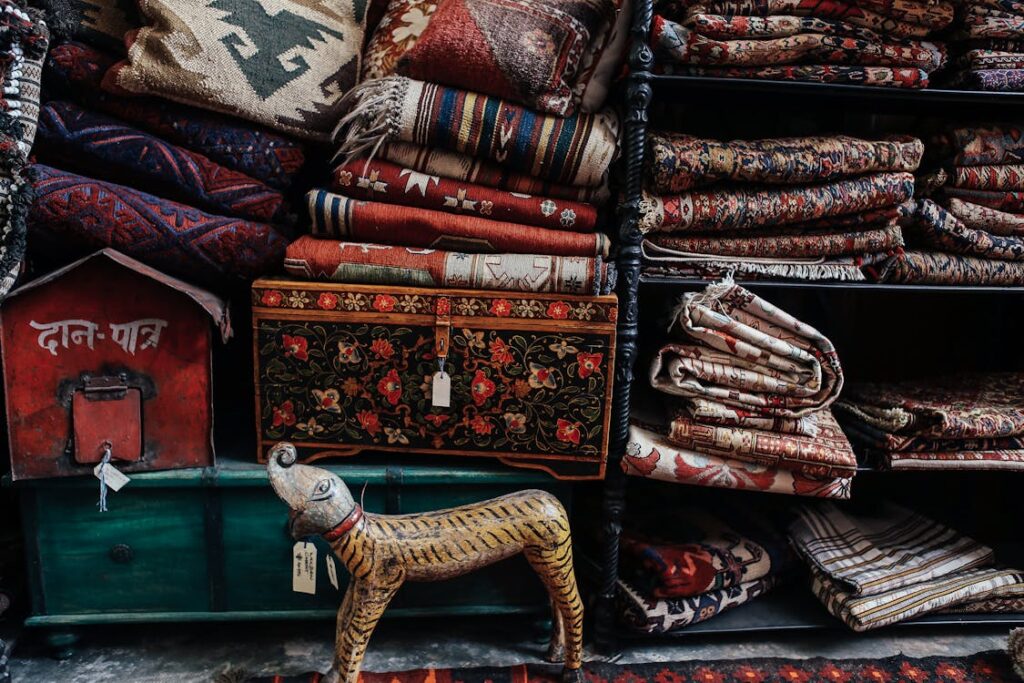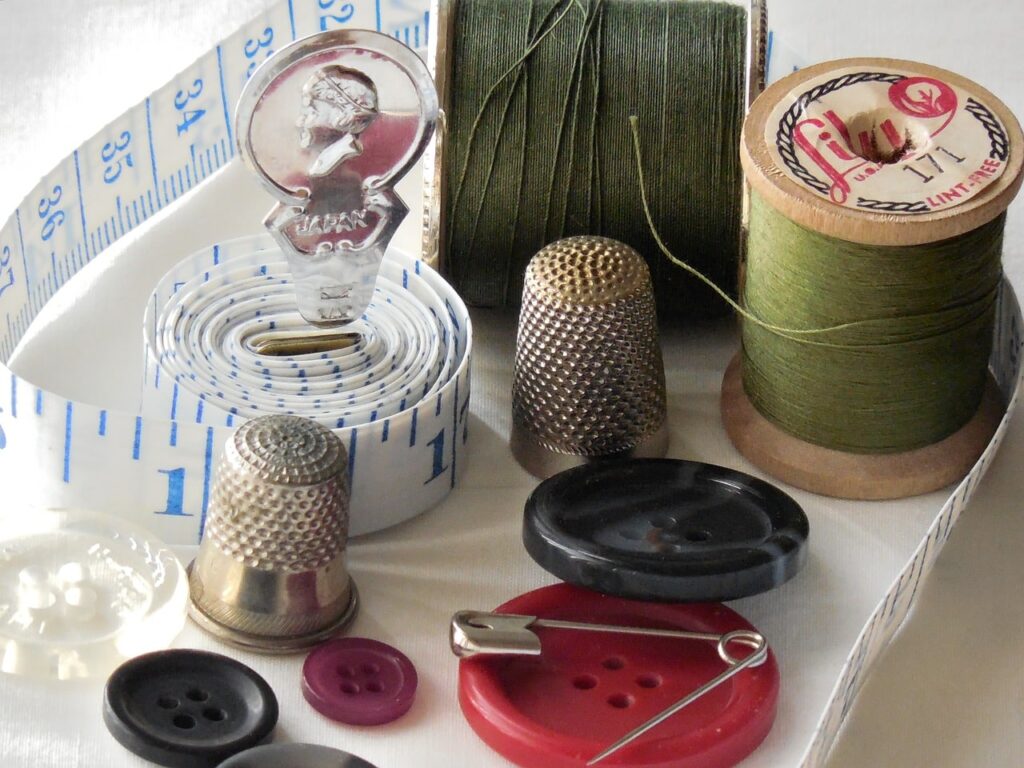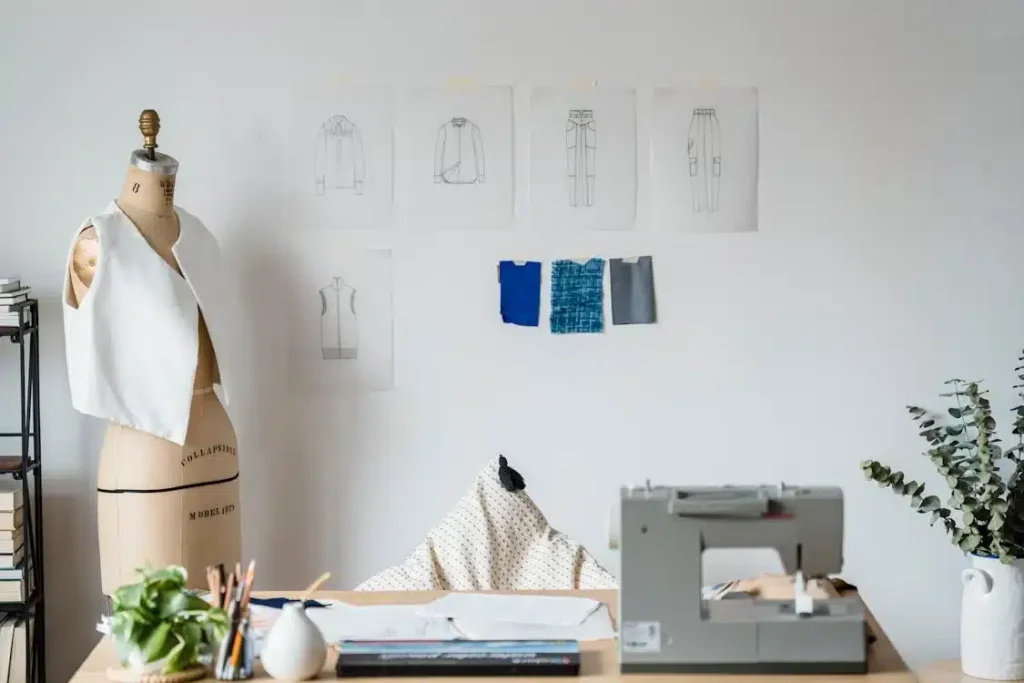Best Sewing Room Organization for Apartments and Small Spaces
You don’t need to wait for your dream sewing space to experience the joy of creating new and exciting projects. Whether you’re living in an apartment or need to use a room for multiple purposes, there are ways to make it work. All it takes is creativity (you have spools of that!) and planning.
How to Maximize Space in a Small Sewing Room or Apartment
Organizing a small space takes planning, especially if you want it to look spacious instead of cramped and cluttered. Write out must-haves for your sewing space, along with some nice-to-have items. Depending on the amount of space, you may have to strike some of the desired items off your list to keep the space looking and feeling organized.
Selecting the Right Sewing Furniture for Small Spaces
Consider how often you’ll use your sewing space while planning. Be realistic about how often you’ll need the space for sewing or something else. You want to avoid making a space-saving decision that creates a hassle for you. Don’t allow a hastily made organizational decision to dampen your enjoyment of creating.
Compact and Multi-functional Sewing Tables
The size and use of your space will determine what kind of sewing table or cabinet you need. Some sewing tables fold down for storage under a bed or a couch. These tables are perfect if you have a multi-purpose space.
Mid-sized sewing cabinets are another option that you can consider. They can collapse to a smaller size, usually about 2 to 3 feet wide. A collapsible sewing cabinet is perfect if you sew more frequently and have a corner or space to place it when not in use.
Additionally, these sewing cabinets often have space for thread spools, fabric swatches, and more to give you additional hidden storage.
Ergonomic Design for Comfort and Productivity
While designing your ideal space, you’ll want to also design for ergonomics. Ergonomics makes the space safer and more efficient for you and your body. Ergonomic furniture and space design can help avoid common health hazards like carpal tunnel and back pain. Still, it can also make you feel more comfortable and productive. Whether you’re sewing as a career or a hobby, “no pain, no gain” may apply somewhere, but it shouldn’t be part of your design.
Here are some tips for designing your space ergonomically:
- Choose a chair with lumbar support
- Choose a well-lit space
- Choose work surfaces that fit your height
Maximizing Space with Clever Organization Techniques
To maximize your space, you should consider three different storage options: vertical, under-the-table, and hidden. Each option uses your available space differently to help you find more space for your things while keeping your floor uncluttered. You can DIY your solution or purchase ready-made organization options; the only requirement for maximizing space is looking at your room with an open mind and fresh eyes.
Vertical Storage Solutions
Vertical storage options allow you to free up available space by using wall and closet space to your advantage. A benefit of a vertical storage solution is that it can improve ergonomics by keeping you from hunching over bins to search for ribbons.
There are multiple ways to store things vertically. One idea is to hang a pegboard on a wall or door to store your supplies. You can make your pegboard storage, and how much and what you store is only limited by your imagination. Depending on your hooks and attachments, you can store anything from spools of thread to scissors and other supplies.
Another vertical storage option is to use shelving to store your fabric. Storing fabric on shelving allows you to see what colors you’re running out of, especially if you’ve organized it by color. Depending on your shelf space, your shelves can also hold your books, magazines, and patterns.

Under-the-Table Storage Tips
If you don’t have any wall space or have used it already and still need more storage, the next space you should look at is the space under your tables. There are many options for using your under-table areas. Those options include rolling drawers, stackable boxes with lids, and tackle boxes.
Hidden Storage Ideas
Like putting a pegboard in a closet, hidden storage is a wonderful way to organize a space while keeping your space tidy. One option for hidden storage is to build yourself a fold-away ironing board. Another idea is to choose a storage caddy that doubles as an ironing and cutting board.
Fabric Storage Solutions for Limited Spaces
Lots of fabric can quickly make your sewing area look messy. The bulk of fabric can cause havoc in a small space. Luckily, you can deal with your fabric in many novel ways to help increase your organizational efficiency, regardless of type.
Efficient Fabric Folding Techniques
Whatever fabric folding method you use, always use the same style to help organize your pieces. One method, made famous by Jan Howell of You Make It Simple, relies on comic book boards cut in half. Depending on the thickness of the fabric, this method works with fat quarters and more significant amounts.
One method that doesn’t use comic book boards is folding fat quarters into squares, as described by Angela Pingle. To fold your fat quarter, you:
- Lay the fat quarter pattern-side down with the short end horizontal to you.
- Fold the piece in half, making the shorter ends meet.
- Fold it in half again; the piece of fabric should now be longer than it is wide.
- Fold both ends of the piece to the center.
- Fold the piece in half to achieve a square shape.
Creative Use of Hanging Systems
As mentioned earlier, using vertical systems frees up floor space for other needs, and your fabric is an ideal fit for hanging methods. Many hanging methods exist, but the three popular systems are dowels, clotheslines, and garment racks.
The dowel system, or the fabric roll storage rack system, might be the best for more significant amounts of fabric. It uses dowels to create rolls of fabric that you can easily take down and cut. Many people make these on their own, but some buy and repurpose gift-wrapping paper systems.
Another popular method for hanging your fabric is the clothesline option. This storage system works with any fabric, provided your clothespins are strong enough. To try it, you’ll need a clothing line and some clothespins. One benefit of this storage system is that it keeps your fabric wrinkle-free and looks like decoration.
The garment rack system utilizes racks and hangers to manage your fabric inventory. The setup is simple, but pick a sturdy garment rack for use with heavy fabric. You don’t want it to collapse under the weight of your creativity.
Vacuum-Sealed Bags for Bulk Storage
If you have a lot of fabric to store, vacuum-sealed bags can help you store your items without taking up too much space. A vacuum-sealed bag can reduce your storage space needs by up to 50%. They remove the air from the bag and squeeze your items into the smaller space.
However, there are some dangers to using vacuum sealing technology. If your fabric isn’t completely dry when sealed, it can grow mold. Moreover, items left vacuum-sealed for over six months can become permanently creased, which may not suit your sewing needs.
Organizing Sewing Notions and Accessories in Small Areas
Small items like cutting tools, needles, thread, pins, and more can easily add too much clutter. Using lots of jars might seem feasible, but they often take up more space than they save. However, you can use several methods to improve the organization of your small sewing items.

Sort and Store Method for Notions
The first step you’ll want to take before storing your small items will be to sort them by type. Make little piles of each type of item. Carefully review each item and think about how often you need them. The review will help you decide where and how to store each notion. You’ll want to put frequently used items in an easily accessible spot. You can then put sparingly used items away for long-term storage.
Multi-Purpose Organizers
Like the ones frequently seen in workshops, Cabinet organizers and tackle boxes can make great multi-purpose organization systems for your sewing notions. They can sit atop a shelf or table or underneath other items for easy storage. Be sure to label your cabinet organizer drawers to ensure identification ease.
DIY Organizers for Personalized Solutions
If you prefer a more customizable solution, do-it-yourself options might be better. You can try shoeboxes, clear plastic containers, or the trusty pegboard; it depends entirely on your creativity and the available materials. What’s best about DIY solutions is they allow your storage to fit your needs exactly.
Innovative Storage Solutions for Sewing Rooms
When organizing an apartment or small space sewing room, the level of innovation used to store items will determine if your area looks arranged or deranged. Luckily, with convertible, modular, and decorative storage options, the possibilities for stylish and functional decor are endless.
Convertible Furniture for Flexibility
Also called multifunctional furniture, convertible furniture can be the secret to a well-organized space. This type of furniture performs two or more jobs in one item. For example, choose a chair that doubles as a chest to store your fabrics. Or you might prefer a storage cabinet that doubles as an ironing station and cutting table to save space. With flexible options, you’ll look stylish while saving space.
Modular Storage for Customization
If you’ve ever had the experience of “growing” out of your shelving, you know how frustrating it is. Luckily, modular or customizable storage can grow and change with your needs. This storage system comprises two or more pieces that can be individually functional or combined for customization to your needs. One example of modular storage is shelving that allows you to customize the height of the shelves to fit your fabric.
Decorative Storage Options
Many DIY and ready-made storage options are decorative. One idea for a do-it-yourself and decorative storage option would be to hang your thread on a pegboard with an ornamental frame. Another example would be the clothesline option mentioned earlier.
Tips for Keeping a Small Sewing Space Organized
After you’ve organized your space, the next step is keeping it that way. If you want your space to look put together, you must regularly maintain the order you’ve created. But don’t worry; there are many ways to keep your space orderly.

Regular Decluttering Sessions
As you’re working on projects, you will run into times when you’ve outlasted the lifespan of a supply or tool. When this happens, it’s time to repurpose, recycle, or remove the item from your space. Holding on to an item for sentimental purposes can be tempting, but it only adds to clutter. You should regularly, maybe even once a month, look through your things for unused, unneeded, and useless items. Then, you should look for some way to recycle or donate them before trashing the items.
Organizational Habits for Sewing Enthusiasts
You can keep your sewing area organized by implementing three simple habits:
- Keep like items together for ease of locating.
- Regularly declutter to keep unneeded items from piling up.
- Seek out swap groups to give old items a new home.
These tips will keep your sewing room organized and look like a professional helped to assemble it.
Take your creativity and organization to the next level with Arrow Sewing‘s range of ergonomic sewing furniture. Our meticulously designed pieces are not only space-savers but are crafted with your comfort and productivity in mind. From compact and multi-functional sewing tables that tuck away neatly when not in use to ergonomic chairs that ensure hours of sewing without discomfort, our furniture is a game-changer for sewing enthusiasts who demand efficiency and style in their crafting space. Check out our offerings today!
FAQ: Sewing Room Organization for Apartments and Small Spaces
What Are the Best Multi-Functional Sewing Tables for Small Spaces?
Multi-functional sewing tables that are compact, foldable, and offer storage are ideal for small spaces. Look for tables that can adjust to different heights and have extendable work surfaces to accommodate various sewing projects while maximizing floor space.
How Can I Utilize Vertical Space for Sewing Storage?
You can maximize vertical space by installing floating shelves, pegboards for hanging tools, and magnetic strips for metal items like scissors and pins. Over-the-door organizers are also great for storing small sewing notions without occupying precious floor or table space.
What Are Some Efficient Fabric Storage Solutions?
Efficient fabric storage solutions include using clear, stackable bins to fold and file fabric, hanging organizers for easy visibility and access, and vacuum-sealed bags for bulk fabric storage to save space.
Can I Store My Sewing Notions in Small Spaces? How?
Yes, sewing notions can be organized in small spaces using magnetic strips for metal items, compartmentalized boxes for sorting different notions, and over-the-door organizers. Utilize clear containers for easy identification and access.
What Unexpected Items That Can Be Repurposed for Sewing Storage?
Unexpected items like spice racks, wine racks, and even shoe organizers can be repurposed for sewing storage. Spice racks are great for small notions; wine racks can hold rolls of fabric or interfacing, and shoe organizers can be used for fabric or pattern storage.
How Do I Organize My Sewing Space with Limited Floor Area?
To organize a sewing space with limited floor area, focus on multifunctional furniture, such as a folding sewing table or a storage ottoman. Use wall space and the backs of doors for storage, and consider under-bed storage for items used less frequently.
What Are the Best Practices for Storing Sewing Machines in Small Spaces?
The best practices for storing sewing machines include covering them to prevent dust accumulation, placing them on a shelf or in a cabinet when unused, and considering sewing machine cases that can be stored vertically to save space.
How Can I Keep My Small Sewing Space Organized Over Time?
Keeping a small sewing space organized over time requires regular decluttering, returning items to their designated spots after use, and reassessing storage solutions to ensure they still meet your needs. Adopting a minimalist approach by keeping only what you need and use can also help.
What Are Some Creative Ways to Store Thread and Bobbins?
Creative storage solutions for thread and bobbins include pegboards with pegs or hooks to hang spools, magnetic strips to hold bobbins, and clear, divided organizers that allow easy visibility and access while sewing.
How Can I Make My Sewing Space Feel Larger Than It Is?
To make your sewing space feel larger, use light colors for walls and furniture to create a sense of openness, incorporate mirrors to reflect light and create the illusion of more space, and ensure adequate lighting to eliminate shadows that can make the area feel cramped.
